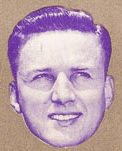
Paul Dietzel
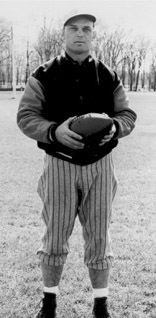
Forrest Evashevski
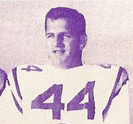
Tommy Davis
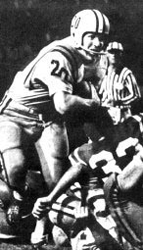
Billy Cannon |
The prognosticators didn't think much of LSU's prospects for 1958. The Birmingham News put LSU at #8 in the 12-team SEC. After all, the Tigers had not been overly impressive in 1957, finishing 5-5 after a 4-1 start. However, junior RB Billy Cannon exuded confidence. "It will be between us and Ole Miss." What did Cannon know that the sportswriters and coaches didn't?
- Fourth-year Head Coach Paul Dietzel installed a whole new offense during spring practice. In preparation for the change, Dietzel invited Iowa coach Forrest Evashevski to speak at the LSU Clinic for high school coaches in the spring of '58. Evy also spent hours with the LSU staff explaining the Wing-T he used in Iowa City and loaned films of Hawkeye games. Dietzel liked the system because it took advantage of the Tigers' speed at every backfield position. Basically a T formation with single wing principles, the Wing-T set one HB next to the FB behind the QB but often stationed the other HB just outside one E where he could come inside for crossbucks and reverses or sprint out for passes. No team in the Southeast had played against the formation.
- Although skeptical at first like almost all members of the coaching fraternity, Dietzel had embraced the weight training that Alvin Roy had originated in Baton Rouge. Spurred by Cannon, whom Roy had trained since Billy was at Istrouma High School, more and more Tigers visited Roy's health club. The work produced stronger, faster players who would not fade late in the season as they had in '57. (By 1959, the whole team lifted.)
- Dietzel's recruiting class of 1956, the finest in school history to that point (and still one of the greatest ever), were now juniors. After gaining valuable experience as sophomores, they were ready to strut their stuff in '58. Add to their number FB-K Tommy Davis from Shreveport who was back from the Army. He would play a crucial role in the new season.
However, the fans believed the forecasters and didn't share the team's enthusiasm for the upcoming season.
- LSU boasted only 9,318 season ticket holders for 1958, a mere 107 over '57. (LSU had not even sold season tickets until 1956 when Jim Corbett took over as AD.) Fans generally saw no need to purchase season tickets because Tiger Stadium had not had a sellout since it was expanded to 67,510 with the addition of the south lower and upper decks in 1953.
- There was plenty of room for the entire student body even if all 10,000 decided to attend.
- The athletic department printed tickets for only 30,000 of the 67,510 seats of the stadium for each home game. More could be printed for individual games based on demand. And demand there would be as the season progressed.
- The ticket policy ignored the fact that LSU had led the SEC in attendance in 1957, spurred largely by the presence of two Baton Rouge high school legends, senior FB Jimmy Taylor and sophomore HB Billy Cannon. Still, the largest crowd had been 59,476 for Georgia Tech.
- Cannon was so certain the season would be a success that during the summer he bought an entire section in the north end zone (@ $3.75 apiece) for the Ole Miss game.
When practice began in September for the opener at Rice on the 20th, Dietzel knew he had eleven solid players who could play on both sides of the ball as required by NCAA rules.
- A player could enter the game twice in each period. If a player started the quarter, he could be replaced and return to the game only once during that period. So today's scheme of employing separate O and D units was not feasible.
- The most common method for replacing players was to substitute an entire second team at several points in each half. Some coaches played the second team an entire quarter while others rested the starters each period depending on the situation on the field.
- LSU had a number of players talented on either offense or defense but not both. For example, T Mel Branch from DeRidder was a jarring tackler but lacked consistency as a blocker. On the other hand, junior Durel Matherne from Lutcher was a slick QB but useless on D. As fall workouts began, the staff searched for ways to utilize players' specific talents.
Dietzel would soon create a unique substitution system that would maximize the diverse talents of his deep but light squad.
|
LSU opened its 1958 season in Houston against the Rice Owls as 6-point underdogs. All seasons start with uncertainty, but this Tiger team raised more questions than usual. The Baton Rouge grapevine hummed with favorable reports about the new O and the staff's optimism. Coach Jess Nealy of the defending Southwest Conference champions didn't know what to expect either. Dietzel told the media the week of the game, "We have the best team speed since I took over. Ten of our 11 starters can run 50 yd in 6.1 seconds or better."
- An all-day rain soaked Rice Stadium, not a situation that benefitted LSU's smaller, faster team.
- No problem, though, as 45,000 watched the Tigers take control immediately. WB Johnny Robinson from Baton Rouge showed his athleticism when he maintained his balance with a hand on the ground after being hit behind the line before scampering 20 yd into the EZ. Robinson also threw a 20-yd pass to Cannon to the 2 to set up the second score, a plunge by FB J. W. "Red" Brodnax from Bastrop.
- Cannon's 30-yd punt return to the 5 set up another TD by Robinson. Rice scored on the first play of Q4 after an INT at the Tiger 37. But a fumble recovery on the enemy 30 led to second string FB Tommy Davis' 5 yd TD to make the final tally 26-6.
- LSU piled up 219 yd to the Owls' 123, with 14 first downs to 7.
- Dietzel got almost three full elevens playing time.
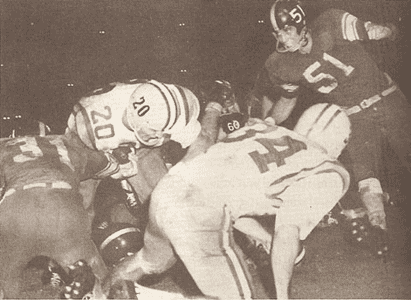 Cannon runs against RiceSince Rice was a consistent power in the Southwest Conference in those days, the victory impressed the pollsters.
- The Tigers entered the next AP poll at 17.
- Dr. E. E. Litkenhaus, who had compiled his own mathematical ratings for decades, suddenly ranked LSU #1.
- Bear Bryant, the new coach of LSU's next opponent, Alabama, attended the game with seven of his assistants. "The big thing is speed. Everyone knows the backs have it, but that line looked awfully quick on a wet field ... I was impressed with LSU's depth, speed, and kicking."
On Saturday night, September 27, the Tigers met the Crimson Tide at Ladd Memorial Stadium in Mobile.
- Bryant inherited an abysmal team at his alma mater from Coach "Ears" Whitworth. Yet he already had earned a reputation as an outstanding coach. So Dietzel knew his former boss (at Kentucky) would have something special ready for the Tigers. He asked his squad to win the game for him. Another staff member with a personal stake in the contest was D line coach Charlie McClendon, who had played for Bear at Kentucky.
- To stop the Wing-T, Bear harkened back to his days in Lexington when he employed the seven-diamond and wide-tackle six defenses against Tennessee's single wing. The unexpected formations held LSU scoreless in the first half.
- Late in Q1, part of the north EZ wooden bleachers collapsed. Play was suspended while the injured were removed.
- Q2 saw a series of plays that set the tone for the season and publicized the substitution system Dietzel had devised. Alabama picked off a Cannon fumble in mid-air at midfield and returned it to the 5. At that point, Dietzel took a chance and inserted his D specialists en masse. The gang-tackling Chinese Bandits, as Dietzel had dubbed the group, held Bryant's first unit to one yard on three tries and forced a FG that gave Bama a 3-0 lead at the intermission.
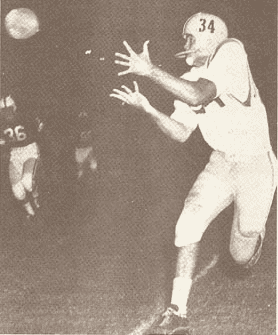 Robinson receives TD pass vs. Alabama
- LSU made adjustments and dominated the second half. QB Warren Rabb, the third Baton Rougean in the starting backfield, began completing passes, which opened up the reverses and counter plays of the Wing-T. The result was two TD drives. 10- and 19-yd runs by Cannon moved the ball to the 7. Rabb then threw a TD pass to Robinson to climax the 67-yd drive. Later, Billy scored the second himself with a 12-yd sprint early in Q4 to clinch the 13-3 victory. Cannon gained 30 of the 44 yd on the drive. As they would do in most games that year, LSU wore down the opposition with superior depth and conditioning.
- Afterwards, Dietzel praised his "third team" for its goal-line stand and revealed his name for them. In the weeks to come, the nickname would catch on with reporters and Tiger fans. A Memphis disc jockey recorded a song about the Bandits that is played to this day by the LSU band when the D unit leaves the field.
- Rice's 30-7 victory at Stanford redounded to LSU's benefit with the pollsters. AP jumped the Tigers to #15 while the UPI coaches poll put them at 17.
|

Johnny Robinson

Red Brodnax

Charlie McClendon

Warren Rabb
|
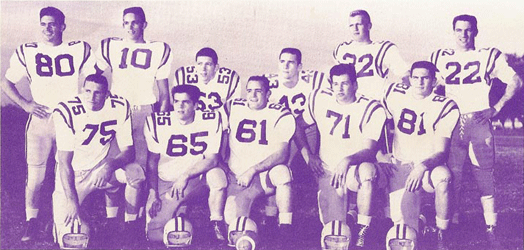
1958 Chinese Bandits
1st row: Mel Branch (75), Emile Fournet (65), Tommy Lott (61), Duane Leopard (71), Gaynell Kinchen (81)
2nd row: Andy Bourgeois (80), Darryl Jenkins (10), John Langan (53), Merl Schexnaildre (43), Henry Lee Roberts (32), Hart Bourque (22)

Scooter Purvis
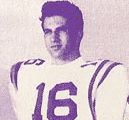
Durel Matherne
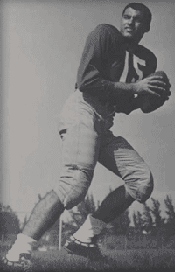
Fran Curci
|
The 2-0 Tigers played their first home game on October 4 against Hardin-Simmons coached by legendary NFL QB Sammy Baugh.
- The morning of the game, Rabb learned that his father had died of cancer at Baton Rouge General Hospital. Dietzel and assistant Carl Maddox told Warren they would understand if he didn't want to play. However, Rabb said his father didn't want him to miss anything because of his illness.
- The attendance of 45,000, while above average for 1958, was disappointing considering the Tigers' #13 AP rank. It was still the largest crowd ever to see Hardin-Simmons play. Baylor had defeated Baugh's team only 14-7 the previous week. The Cowboys' line actually outweighed the home team's by 211 per man to 197.
- Two Q1 TDs gave the impression that this would be an easy night for the home team. The grieving Rabb scored from the 2 to end a 65-yd drive. Then Warren's backup, Durel Matherne, ran in from the 4 following a fumble recovery at the HS 43 by G Ed McCreedy from Biloxi and a 28-yd reverse by Cannon's understudy, Scooter Purvis, another Mississippian (Crystal Springs).
- But the Cowboys refused to fold. Baugh devised a ball-control passing attack to keep LSU's speedy backs on D or on the sidelines. The old pro's boys mounted an incredible 22-play 94-yd drive to pull to 13-6 in Q2. Later in the period, though, a bad snap on a punt put the Tigers in business at the 11. On the first play, Cannon popped into the EZ for a 20-6 halftime lead.
- The visitors ran 86 plays to LSU's 59 and played a scoreless second half. The Tigers drove to the enemy 24 with the second half kickoff but failed to score. Davis helped keep the Cowboys at bay by averaging 50 yd on four punts.
- Impressed with Cannon, who got loose on a 35-yd run, Baugh said, "He's as great as any back I've ever laid eyes on."
The #11 Tigers took to the road again to play the Miami Hurricanes on Friday night, October 10. Andy Gustafson's squad, which had lost to #6 Wisconsin 20-0 in their lone game so far, was a one-point underdog. Gustafson planned to play a physical, ball-control game against the quicker visitors behind 148-lb QB Fran Curci. However, the humid weather would give the Tigers' depth another chance to assert itself before the Orange Bowl crowd of 40,614.
- The Gold team took over on LSU's second possession in the scoreless game. On the third play, Purvis took a pitchout and scooted 51 yd for the first TD. Davis, however, missed the PAT.
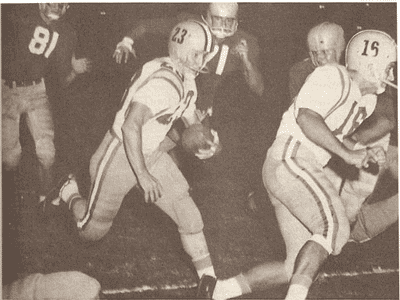 Scooter Purvis goes 51 yd for TD
- In Q2, Miami fumbled a Davis punt at its 20 to set up the second Tiger TD. Rabb passed to Hendrix for the 15-yd score.
- Curci then led Miami's only serious drive of the night. He mixed option runs with left-handed passes to reach the 6. However, LSU held to lead at the half 13-0.
- The second half was all LSU. Cannon returned the kickoff to the 48. Six plays later, Rabb passed 25 yd to Robinson to the 3, from where Brodnax took it in.
- The low point for the home team in the 41-0 shellacking came in Q4 when a short Miami punt bounced off the head of a Hurricane. The 15-yd penalty for illegal touching gave LSU possession at the 16. The first play put the ball on the one foot line, from where Cannon plunged in.
- The Tigers added two more TDs over the worn-down Canes to hand Gustafson his worst defeat since becoming head coach in 1948. Davis accounted for both scores on a 4-yd pass from Matherne and a 7-yd run that climaxed a 60-yd drive.
- The 41-0 defeat was the first time Miami had been shutout since 1927.
- Davis, star of Fair Park High's 1953 state champs, had his best game of the young season. He rushed for 62 yd and averaged 41.3 yd per punt. For this effort, Tommy was voted SEC Back of the Week – and he was second string!
After the game, LSU's #2 offensive unit inadvertently received a new name. Because a reporter misheard Dietzel talk about the "Gold team," his Miami Herald article referred to the "Go team," and the label stuck.
|
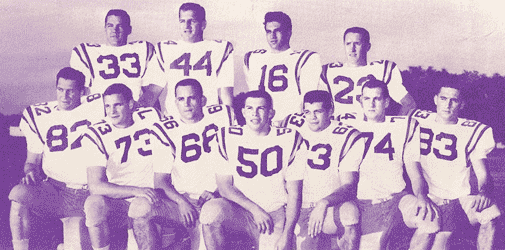 1958 Go Team
1st row: Don Norwood (82), Jack Frayer (73), Mike Stupka (68), Bobby Greenwood (50), Al Dampier (63), Dave McCarty
(74), Scotty McClain (83);
2nd row: Donnie Daye (33), Tommy Davis (44), Durel Matherne (16), Don Purvis (23)
The Tigers, 4-0 for the first time since 1937, cracked the AP Top Ten at #9 as they prepared to host Kentucky on October 18. Blanton Collier's Wildcats had just lost only 8-0 to #1 Auburn, the preseason favorite to win the SEC. Yet, the oddsmakers installed LSU as 12-point favorites, partly because UK's QB, Lowell Hughes, the SEC's leading passer, would not play.
- The game attracted the largest crowd in LSU history, 65,000. The undefeated record, the exciting O, the three-team system - all contributed to the unprecedented demand for tickets. The newfound fans would not be disappointed.
- Cannon immediately brought the crowd to its feet with a 35-yd return of the opening kickoff. A snappy 59-yd drive showed all the tricks in the playbook - double reverses, counters, and QB rollouts. Also, Dietzel had added a new wrinkle. Two backs flanked outside the split end to open up the middle for Cannon, the lone back behind Rabb. Brodnax closed the march with a 2-yd dive. It had taken Auburn three quarters to score on the Wildcats. LSU had done it in four minutes.
- However, the visitors roared right back to tie the score 7-7.
- LSU seized the lead for good in Q2 on a 19-yd pass from Rabb to Hendrix.
- Repeating the pattern established in the first four games, the Tigers dominated the second half. Cannon scored on a 19-yd run and kicked the PAT himself. Then E Don Norwood grabbed a 5-yd pass from Matherne in the EZ to make it 26-7 after three periods.
- The only scoring in Q4 was a Cannon 2-yd run to make the final tally 32-7.
- Rabb completed 6-of-9 for 80 and Matherne 4-of-7 for 71. Cannon gained 108 on 12 carries.
- Kentucky gained only 136 yd and failed to make a first down against the Bandits.
Asked to compare the two Tiger teams, injured QB Hughes said, "They're not as tough up front as Auburn, but their offense is much better. The way they executed tonight, they could move the ball against anybody ... Auburn included. All around, they're a better team."
The 5-0 start was LSU's finest since 1929 and vaulted the Tigers to #3 in the AP poll and #5 in the UPI – the highest since 1937.
Next, the big bad Florida Gators came to town.
- Boasting the nation's third-ranked rushing D (65 ypg), Bob Woodruff's 2-1-1 squad had as much size and depth as any team in the conference. This might be one team the Tigers could not wear down.
- Two weeks earlier Florida had traveled across the continent to gain a 21-14 victory over UCLA in which they held the Bruins to 65 yd while rushing for 273 themselves.
- Dietzel sent assistant coach Abner Wimberly to scout Florida. He reported, "Florida plays as many or more people than any eam in the country. Up to now, we've been able to wear the other team down. If we beat Florida, it won't be because we'll wear them down."
Another large but short-of-sellout crowd (63,000) watched the season's toughest home game.
- Expecting a tight contest, Dietzel told his kicker during pregame warmups, "Warm up that toe, Davis."
- Florida drove deep into LSU territory in the opening period. But after E Don Fleming couldn't hold QB Jimmy Dunn's pass at the 4, Billy Booker missed the FG.
- LSU scored its only TD of the night on a 59-yd Q2 march that featured Robinson's 11-yd run and Rabb's 22-yd pass to soph. E Mickey Mangham from Kensington MD. Cannon muscled over from the one on fourth down. Davis toed the PAT.
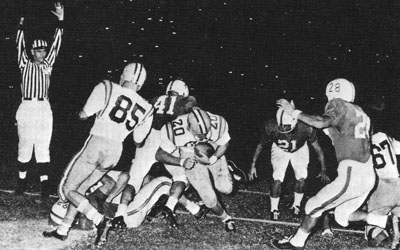
Cannon scores over Florida All-American T Val Heckman.
- The 7-0 lead lasted into the early minutes of the final quarter and might have survived the entire game except for a gaffe by Cannon. Bottled up by Dunn's coffin corner punting most of the game, LSU decided to quick kick. But Billy shanked the ball out of bounds on the Tiger 25.
- It took the Gators only five plays to capitalize. Sub QB Mickey Ellenburg threw two 14-yd passes, the first to E Dave Hudson and then to Perry McGriff for the score. Booker booted the EP to tie the score.
- The White Team had to move into FG position against one of the nation's best defenses. But their first possession ended in a punt, and the visitors immediately started driving again. But Cannon intercepted a pass at the 18 and, fighting off a tackler with one hand, lateraled to Hendrix who ran out to the LSU 40.
- Again, the Tigers went three-and-out, and the crowd began to resign themselves to a tie. But Florida couldn't move either and punted only to its 43.
- Facing the loss of their perfect record and high ranking, the Tigers ran Cannon right at the Gators' 231-lb All-American T Val Heckman. Billy carried four times for 20 yd to get into FG range at the 19 with 2:59 left.
- Fortunately, the nonchalant Davis didn't feel pressure as much as others. He calmly booted the FG to send the crowd into a frenzy.
- UF won the statistical battle with more first downs and yards (288-181 total and 151-89 on the ground). Once again, the Bandits pitched shutout ball during their innings.
The victory, coupled with #1 Army's 14-14 tie with Pitt and Ohio State's 7-7 deadlock with Wisconsin, propelled LSU to the top of the AP poll for the first time ever. Sitting at #6 was another 6-0 team, the Ole Miss Rebels, the next foe to visit Tiger Stadium.
|
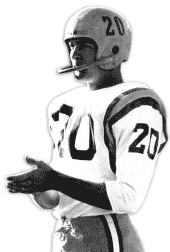
Billy Cannon

Don Norwood
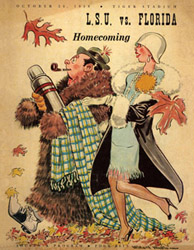
LSU-Florida Program 1958
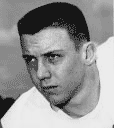
Mickey Mangham
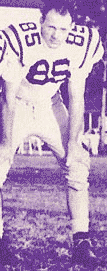
Billy Hendrix
|
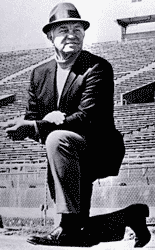
Johnny Vaught
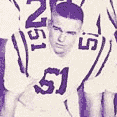
Max Fugler
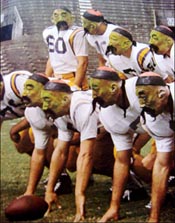
Chinese Bandits in costume
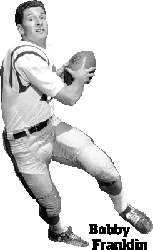
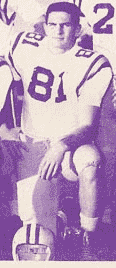
Gaynell "Gus" Kinchen
|
The biggest game in the history of Tiger Stadium to that point took place on November 1, 1958, when the #6 Ole Miss Rebels, 6-0, faced the #1 Tigers, also 6-0. The SEC championship as well as the national championship were on the line. Paul Dietzel had emulated Johnny Vaught's Rebels in many ways in his own program, from conditioning methods to uniform design. Ole Miss had won 35 games the previous four years. This game would be the supreme test of how far LSU had come under the Corbett/Dietzel regime.
The unprecedented excitement and electricity on campus and in Baton Rouge were recalled by the players decades later.
- Junior C/LB Max Fugler from Ferriday LA: "The students kept a fire burning on top of two mounds in front of the Field House the entire week. The game itself is indelible probably due to the crowd noise and the intensity. It was the only time I ever really heard the crowd noise while I was playing." Max would play a crucial role in the contest.
- "Go to Hell, Ole Miss," banners and graffiti dotted not only the campus but the city. Coolie hats were a hot item.
- An airplane bombarded the LSU campus with "Go to Hell, LSU," leaflets. Many wondered whether Dietzel was responsible for the ploy as a way to fire up the team and fans.
- Ads seeking tickets filled the newspapers and airwaves. Scalping was rampant. Billy Cannon, who had bought out an entire section of the north end zone in the summer @$3.75, made a pretty penny from the sale of those tickets.
- Since the NCAA controlled telecasts and drew up the schedule before the season began, the game was not on TV despite its national allure. New Orleans' clear-channel radio station, WWL, beamed the game nationwide.
- Reporters from all over the country crowded the pressbox.
- A crowd of 67,510, the first sellout in the expanded Tiger Stadium, began gathering hours before the 8:15 kickoff, starting a tradition that continues to this day.
It would have been hard for the game to live up to all the hype but, from the LSU standpoint, it did.
- After a scoreless Q1, in which Davis's punting kept the Rebels at bay, the visitors got a break when that same Davis fumbled the snap on a punt on the LSU 41.
- With QB Bobby Franklin alternating carries with HB Cowboy Woodruff and FB Charlie Flowers, Ole Miss drove to a first down on the 2 at the south end of the field.
- The crowd stood as one, roaring on every play.
- First down: QB Bobby Franklin sneaked to the 1-foot line. However, LSU was offside. Amazingly, captain Kent Lovelace declined the penalty, choosing to have three downs from the 1-foot line rather than four from the 1-yard line. "I didn't think any team in the country could keep us from scoring from the 1-foot line in three downs," Lovelace explained later.
- Fugler stopped two successive runs short of the goal.
- On fourth down, Max teamed with Cannon to stop Lovelace on the three.
Two Robinson runs moved the ball out from the shadow of the goal posts, and LSU punted from its 33. The next few minutes demonstrated the genius of Dietzel's substitution plan.
- After Ole Miss punted back, the Go Team entered and drove to the Rebel 26. However, Davis missed a FG try.
- The Bandits took the field, and, two plays later, E Gus Kinchen from Baton Rouge pounced on a Billy Brewer fumble at the 21.
- The White Team came back and scored in six plays. Cannon tossed 6 yd to Robinson, and Rabb connected with Cannon for a first and goal from the 9.
- Facing fourth down at the 5, Rabb went back to pass but ran away from two rushers and fought his way over the goal line. With Davis prevented by the rules from returning to the game that quarter, Cannon kicked the PAT to make the score 7-0 with only 0:25 left before halftime.
- Ole Miss threatened again in Q3, but Fugler got a hand on Bobby Khayat's FG try at the LSU 26.
LSU tucked the game away late in Q4.
- The Go Team recovered its own partially-blocked punt on the Ole Miss 33 to gain new life.
- Three plays later, QB Matherne duplicated Rabb's earlier score by scooting 5 yd into the end zone. Davis converted to make the final score 14-0.
- From the AP article on the game: "The angry battle ended with the LSU cheering section chanting, 'We're number one. We're number one.'"
- The statistics reflected the score. LSU held the edge in first downs, 14-9, and total yardage, 174-121. Ole Miss attempted only three passes and completed none.
- The fact that LSU scored in the late minutes of each half reflected the depth created by the three-team system. New Orleans States-Item columnist Pie Dufour wrote on the following Monday: "By a stroke of psychological genius, Coach Paul Dietzel has given a different personality to each of this three teams but endowing all with the same fierce pride in giving 100 percent effort on each assignment."
LSU and Rutgers were left as the only unbeaten/untied major college teams. The Tigers continued to be #1 in the AP poll but were second in the UPI behind Iowa despite the fact that the Hawkeyes had been tied by Air Force in their second game. Fugler was voted national lineman of the week. Duke was up next, the last of four straight home opponents. Would the Tigers suffer a letdown after their epic defeat of the Rebels?
|
LSU, 7-0, ventured out of conference to host the 3-4 Duke Blue Devils of the ACC on November 8 in the season's final home game. Would Dietzel have his team focused after arguably the greatest victory in school history, the 14-0 triumph over Ole Miss? Bill Murray's team boasted a large line and a ball control O, precisely the style that might give the Tigers trouble.
- With a line that averaged 214 to LSU's 197, Duke stopped the Tigers' opening possession and took over at their 37. The Devils ran straight at the smaller Bandits from an old-fashioned T formation directed by QB Bob Brodhead (who, 24 years later, would succeed Dietzel as LSU's AD). Ten plays later, one HB, George Dutrow, threw to the other, Wray Carlton, in the EZ. It was the first TD scored on the Bandits all season. The crowd of 65,000 was silenced but not for long.
- It took precisely 41 seconds for the White team to tie the game. After the kickoff return to the 37, Rabb, who noticed that Duke played its HBs close on the previous series, hit Cannon in stride with a pass down the middle, and Billy ran untouched to the end zone.
- The score remained 6-6 going into Q2. That's when the Tigers exploded. The Bandits started the fun when Bogalusa's Jr T Emile Fournet blocked a quick kick, and Kinchen recovered on the 2. Dietzel rewarded his D specialists by leaving them in. Jr. FB Merl Schexnaildre from Houma scored up the middle to get back the TD they gave up. Cannon came in to kick the PAT.
- The second TD of the period came after a penalty and a poor kick gave LSU the ball on the Duke 35. Four plays later, after a pass interference call in the EZ, Brodnax blasted over from the 1 to make it 20-6.
- The onslaught continued when Sr. White team G Larry Kahlden (Weimar TX) recovered a fumble on the Devil 46. Five plays later, Rabb hit Red Hendrix from the 8 for a 28-6 lead at the half.
The second half brought more offensive fireworks, mostly by the home team.
- LSU showed the versatility of its offense in Q3. After running two sweeps to the right, Rabb sent Cannon in motion that way to draw the HBs and handed the ball to Robinson who burst 45 yd up the middle to paydirt. The two-point conversion made it 34-6.
- Duke cranked up another drive at that point. Carlton returned the kickoff 55 yd before being tackled from behind at the 35. Facing the Bandits, Brodhead completed two passes for a first down at the 11, then fired another to E Claude Moorman for the score.
- LSU tacked on two more TDs in Q4. Cannon rambled 25 for one and Go team QB Matherne ran in from the 8 after Purvis returned a punt 56 yd.
- Duke added a third TD to make the final score 50-18.
- The defeat was Duke's worst in 29 years. But if ever there was a game that shows statistics can be misleading, this was it. Duke outgained LSU 353 to 285 and recorded 24 first downs to the home team's 11. But the visitors fumbled eight times and lost five.
Despite Iowa's 28-6 victory over Minnesota, the UPI Coaches moved LSU to the top. The Tigers nearly tumbled from their lofty perch the very next week.
LSU met Mississippi State at Jackson on the night of November 15. Hinds Memorial Stadium could hold only 26,000, but many thousands more would have attended if there were space. Once again, Dietzel's crew faced a larger opponent. But this time two days of rain made the playing field a muddy mess that partially negated the Tigers' speed and passing advantages. Having beaten LSU five of the last six years, the veteran Maroons, led by senior option QB Billy Stacy, presented numerous problems despite suffering a series of injuries and discouraging defeats.
- The showers stopped shortly before game time, but the contest started badly when Cannon mishandled the kickoff and was smothered on the five, putting LSU in a hole it didn't get out of until State scored.
- LSU's second and third possessions started from the 5 and the 12. They ran only seven plays in the period and never got past the 21 until four minutes into Q2.
- State reached the five on its first drive, but Cannon batted down a fourth-down pass in the EZ. The Maroons came right back, reaching the 7 before another fourth-down pass went awry.
- Cannon fumbled on the 20, and Willie Daniel recovered. State reached the 13, but T Bobby Tribble missed a FG on the first play of Q2.
- Tribble atoned for his miss by pouncing on another fumble, this one by Go team HB Donnie Daye (Ferriday LA) at the 23. The fourth time was the charm as Stacy scored from the 10 after rolling out to pass. Tribble missed the PAT, which would prove to be crucial.
- LSU finally moved the ball after MSU's score. The Tigers drove to the 17, but a 15-yd penalty moved them out of FG range. A fourth down pass from the 33 fell incomplete.
Given the playing conditions, the 6-0 halftime lead seemed like 16-0. "We were playing in water up to our ankles in some places," said Don Norwood. "The end zones were particulary bad."
- Early in Q3, the Tigers finally got a break when Brodnax recovered a fumble at State's 34. Red ripped off several runs for 16 yd to set up a fourth-and-goal at the 5. Rabb threw to Hendrix for the TD, and Davis calmly booted the PAT for a 7-6 lead.
- State got a great chance early in Q4 when J. E. Logan recovered another Cannon fumble at the LSU 16. But the D held, and Tribble missed the go-ahead FG from the 10.
- Cannon kept the Bulldogs bottled up with his punting, one of which went out on the 2 with another rolling dead on the 3. Stacy lost two fumbles later in the quarter to snuff out any possibility of victory. Hendrix caused the last fumble at the State 28 where Rabb recovered.
For the second week in a row, LSU's opponent won the statistical battle. MSU had 10 first downs to 7 and 191 yd to 156. Cannon gained 57 on 13 carries and rambled 25 yd on a screen pass.
Ohio State helped LSU's cause by defeating Iowa. So the Tigers needed only to beat archrival Tulane in New Orleans to wrap up a 10-0 season, the SEC championship, and the #1 rank in both the AP and UPI polls. A Sugar Bowl bid was rumored to be in the offing as well.
|
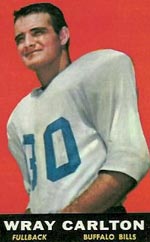
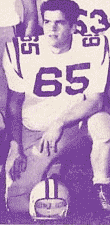
Emile Fournet

Merl Schexnaildre
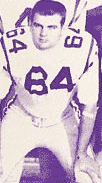
Larry Kahlden
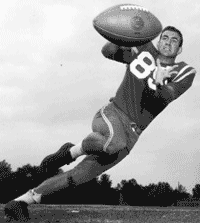
Claude Moorman
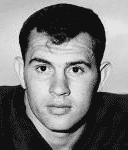
Billy Stacy
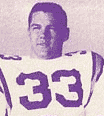
Donnie Daye
|
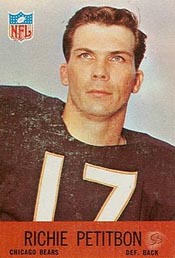

Max Fugler
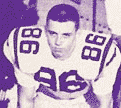
Mickey Mangham
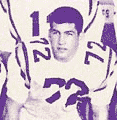
Bo Strange

Larry Khalden
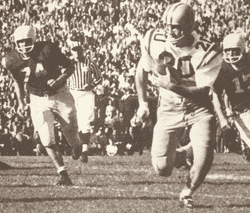
Cannon runs 45 yd for final TD
|
All that stood between LSU and a perfect season was Tulane. At 3-6, Any Pilney's Green Wave didn't seem to pose much of a threat. Any chance the Tigers would take the game for granted vanished when they read a statement by Greenie HB Claude "Boo" Mason.
- On the train ride back from the 12-0 loss to Vanderbilt, Mason remarked to New Orleans States-Item writer Cro Duplantier, "LSU will choke."
- Always alert for any psychological advantage, Coach Dietzel cut out Mason's quote, had copies printed, and papered the locker room walls with it.
- Dietzel also adopted the slogan: "Don't let Petitbon get a thousand." He was referring to QB Richie Petitbon (future All-Pro DB with the Chicago Bears) and his quest for 1,000 yd of total offense, which was quite an achievement in an era of limited substitution and offensive production.
- Probably in deference to the passion of the rivalry, the oddsmakers installed LSU as only a 14-point favorite.
The largest crowd ever for a regular season game in the South, 84,000 (or 83,000 or 85,000 depending on which account you believe) packed Tulane Stadium on an unseasonably warm day. The $250,000 share each school earned from the gate was larger than most bowls paid.
- Bear Bryant had proclaimed Tulane the best defensive team his Tide had faced all year. And for two quarters, the Greenies lived up to the billing, holding the Tigers to a 6-0 halftime lead.
- After Pilney's determined D turned back two threats in Q1, LSU finally dented the scoreboard in Q2. The Tigers powered 75 yd in 11 plays, with "bow-legged HB Billy Cannon" (to quote the UPI article) spinning into the EZ from the 5.
- During halftime, the Tigers agreed their hosts were already tired. The three-team system would work unbelievably well in the second half.
- Early in Q3, Max Fugler picked off a Petitbon pass, returning it to the TU 30. From the 7, QB Warren Rabb rolled out to pass but decided to run and crashed through three would-be tacklers for the TD. Davis booted the PAT.
- Soon LSU was on the board again. Johnny Robinson skirted RE untouched for 34 yd. Rabb passed to Mickey Mangham for the two-point conversion.
- The Tigers got another chance when QB Carlton Sweeney fumbled, and Bo Strange recovered on the 10. Cannon bolted over on the first play. This time, the pass for two failed leaving the score 27-0.
- Late in the period, the home team reached the LSU 30, but Cannon intercepted at the 10.
Q4 would show both the beauty of Dietzel's three-team system as well as the inflexibility of the 1958 substitution rules.
- When the quarter changed, the Go Team had the ball deep in LSU territory and had to punt. They returned with nine minutes left, and Scooter Purvis took a screen pass 54 yd to the EZ. The PAT try failed. When the Go Team left the field, they could not return because of the substitution rules.
- The Bandits stuffed the next possession and forced a punt to the Tulane 45. The Bandits were drilled to run a few offensive plays, but, with their QB, Darryl Jenkins out with an injury from the Mississippi State game, Dietzel removed them, ending their day as well.
- So the White Team had to play the rest of the way. Robinson scored on a 5-yd pass from Rabb. Cannon ran in the two-point try. 41-0 with 6:15 left.
- Johnny caught a short punt at full speed and sped 34 yd for the next score. This time Cannon kicked the PAT.
- A botched quick kick gave LSU another short field when Larry Kahlden recovered at the 10. Penalties and losses pushed back the Tigers, but Robinson made a leaping catch of a 23-yd Rabb pass for his fourth TD of the day. Purvis added the placement to make it 56-0.
- The last TD still irritates Tulane fans to this day. Red Hendrix intercepted Sweeney at the 48 and lateraled to Purvis at the 45. Scooter was speared by a tackler and had to leave the game. The only back on the bench who could return to the game was Cannon, who thought his day had ended. Dietzel told him to go in and tell the QB to fall on the ball. Instead, he called a pitchout to himself and raced to the EZ. The conversion missed, leaving the score 62-0. Cannon laughed about it years later. "Pilney was on one sidelines cussing Dietzel for ... running up the score. Dietzel was standing on the other screaming, 'It wasn't me. I didn't call it.'" Still, as Dietzel said later, "It would have been more humiliating if we had punted on first down in the fourth quarter."
- Incredibly, Tulane threw one more INT, Robinson snagging it at the 28 and returning it to the 35 where he and Cannon lateraled it back and forth before Johnny fell down at the 32.
- The estimated 50,000 LSU fans in attendance shouted, "We're No. 1, We're No. 1!"
Robinson was named the UPI Back of the Week for his four TD effort, scoring on a run from scrimmage, two pass receptions, and a punt return. An overlooked aspect of the game was Tommy Davis's punting, which helped pen the Greenies in the first half. He averaged an amazing 51.2 yd on five kicks.
Right after the game, the Sugar Bowl officially invited LSU to host the January 1 game. AD Jim Corbett foresaw some uncomfortable moments dealing with the many Tulane graduates on the Sugar Bowl committee. He had left the pressbox with time remaining to head to the locker room. "I hope we don't score again," he told a bystander. The Tigers scored two more TDs.
|
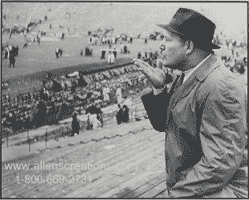
Frank Howard

Paul Dietzel
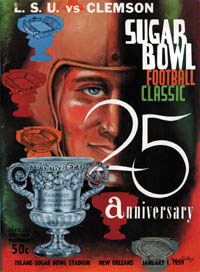
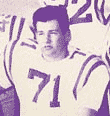
Duane Leopard
|
The college football world was generally disappointed by the matchup the Sugar Bowl put together. Most hoped for a more formidable opponent for #1 LSU than the #12 Clemson Tigers, champions of the Atlantic Coast Conference. Frank Howard's team had won their first four before losing at in-state rival South Carolina in the annual rivalry game on the Thursday morning of the state fair, 26-6. After edging Wake Forest 14-12, the ACC Tigers were shut out by Georgia Tech, 13-0. Clemson then won the final three games to finish 8-2. LSU had played in four Sugar Bowls (1936, 1937, 1938, and 1950) and lost them all. The 25th annual New Orleans classic seemed certain to be the game that broke the drought as LSU entered the fray as a 15-point favorite. This would be LSU's first appearance on national TV.
The two head coaches couldn't have presented a bigger contrast.
- 49-year-old Frank Howard, a native of Barlow Bend AL, was a "slow-talking, tobacco-chewing, quick-quipping country boy who relished the role of the underdog." He had coached Clemson since 1940 (and would continue through 1969). His best season had been 1948 when the Tigers finished 11-0, ending with a 24-23 victory over Missouri in the Gator Bowl. Frank believed in old-fashioned Southern football: run the ball and play good D.
- 34-year old Paul Dietzel, Ohio born and bred, "smooth and calculating," had experienced his first year of success in his brief (four-year) head coaching career for which he was named National Coach of the Year by the College Football Coaches Association and the the Football Writers Association of America. Dietzel had vaulted his team to a higher level by installing the Wing T O and concocting the three-team system to skirt the substitution limitations the rules imposed.
- Howard charmed sportswriters with his down home wit. "LSU has the Chinese Bandits. Our boys play like one-armed bandits." And: "Dietzel's got his Chinese Bandits, and I am bringing my Mongolian Idiots." Howard relished the underdog role and had his team prepared to carry the fight to the deeper, faster LSU Tigers.
- Clemson's size worried Dietzel. "They look like Duke. And we never did stop Duke. We'll be giving away 20 pounds per man in the line."
The underdog held its own during the scoreless first half.
- Howard's upset plans were buoyed by the injury to All-SEC QB Warren Rabb, who broke his right hand in Q2.
- With Bandit QB Daryl Jenkins still sidelined by injury, LSU had only one signal-caller left – Durel Matherne of the Go Team. Not only was he less talented than Rabb, but Dietzel didn't want to risk getting him hurt. So no rollouts were called, removing an effective option from the LSU O.
LSU squandered three scoring chances in Q2, losing fumbles twice.
- On the first play of the period, after a drive from the 25 to the 25, Matherne fumbled the ball away.
- A few minutes later, the Bengals partially blocked a punt to gain possession on the enemy 29. They drove to the 12 where Rabb missed on four straight aerials.
- Then, most frustrating of all, LSU drove from its 44 to the 1. Red Brodnax fumbled as he leaped into the EZ. The officials ruled that he did not cross the goal line before he lost control of the ball, which Clemson recovered for a touchback.
As had happened so often during the magical season, an opponent's mistake gave the SEC Tigers an opportunity they cashed in.
- Late in Q3, Duane Leopard recovered a bad pass from center on a punt attempt at the Clemson 11.
- After two plays netted only two yards, Matherne handed off to Cannon, who, running to the right, threw a pass to Mickey Mangham in the EZ. Cannon kicked the PAT to complete the scoring for the day.
|
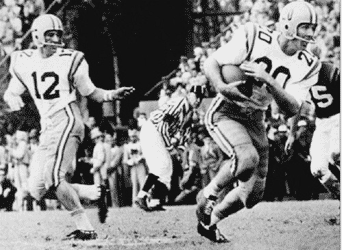 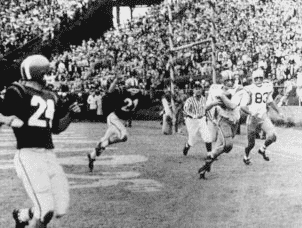
Left: Rabb hands to Cannon; Right: Mickey Mangham catches TD pass from Cannon |
|
As Dietzel feared, the Clemson front wall gave his Tigers trouble all day. Outgaining LSU on the ground 195-134, the Tigers mounted two sustained drives.
- In Q3, Howard's crew moved to the LSU 26 where Bo Strange recovered a fumble.
- In the final period, Clemson finally threw some passes, completing two for 23 yd, as they drove from their 16 to LSU's 24 where they gave up the ball on downs.
- LSU then maintained possession until the final gun.
Cannon, despite being held to 51 yd on 13 carries, won the MVP trophy. Howard singled out Strange for praise.
Strange was the man we figured to be the weak link in the LSU team. We figured we could drive him back 10 yards at a crack, but as it turned out, he was the toughest man on the field.
For the season, LSU outscored the opposition in every period. Particularly glaring were the third and fourth quarter margins: 70-6 and 98-19.
The AP customarily issued its final poll before the bowl games in those days. Other rating systems waited until after the bowl games. When the dust settled, only the Football Writers Association of America did not rank LSU #1. Instead they chose Iowa, which trounced California in the Rose Bowl 38-12 to finish 8-1-1. The Tigers swept the rest: Berryman, Billingsley, Boand, DeVold, Dunkel, Football News, Football Research, Helms, Litkenhouse, National Championship Foundation, Sagarin (retroactively), United Press International, and Williamson.
The 1958 season has never been duplicated by an LSU team. The 2003 BCS champions lost one game while the 2007 BCS winners lost two games, both in double OT.
|
|
CONTENTS
Preseason
Games 1 and 2
Games 3 and 4
Games 5 and 6
Game 7
Games 8 and 9
Game 10
Game 11 - Sugar Bowl
Other Seasons in Time
Notre Dame 1924
Providence Steamroller 1928
Stanford 1940
Wisconsin Badgers 1942
Alabama 1966
Miami Dolphins 1972
LSU 2005
Football Magazine
Golden Rankings Home
|


 Cannon runs against Rice
Cannon runs against Rice Robinson receives TD pass vs. Alabama
Robinson receives TD pass vs. Alabama





































